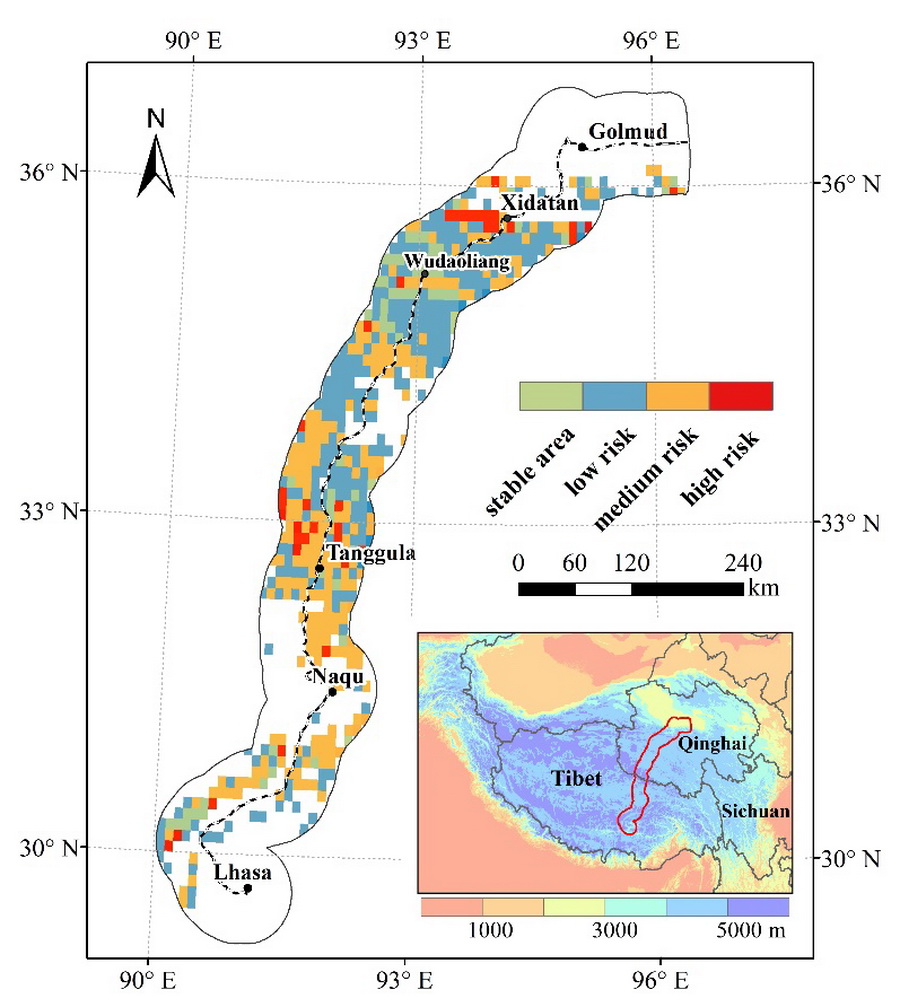Scientists Assess Risk of Thaw Settlement in Permafrost Regions of Qinghai-Tibet Plateau
Updatetime:2021-04-25From:
【Enlarge】【Reduce】
As a member of the cryosphere elements, permafrost has been confirmed by more and more studies for its indicative role in global climate change. The permafrost in the Qinghai-Tibet Plateau (QTP) is characterized by high temperature, high ice content, and sensitivity to the environment.
In recent years, with the climate warming, the permafrost in the QTP is showing different forms of degradation, and the induced thaw settlement disaster seriously affects the engineering construction and the environment of the permafrost areas.
Recently, Prof. WU Tonghua with his team from the Northwest Institute of Eco-Environment and Resources (NIEER) of Chinese Academy of Sciences (CAS) used a combination of multi-evaluation index models, including the settlement index (Is), the risk zonation index (Ir), and the allowable bearing capacity index (Ia), to assess the potential thaw settlement risk in permafrost regions of QTP.
Through comparative analysis of the three results, researchers found that the final simulation results are quite different due to the different influencing factors (mainly including ground ice content, mean annual ground temperature and relative changes in active layer thickness, etc.) considered by each model.
Therefore, a modified consistency index (Ic) model was proposed and applied to assess the thaw settlement risk assessment on the permafrost region of the QTP (stable area, low-risk area, medium-risk area, and high-risk area). The Ic model takes full account of the commonness among the models, which can guarantee the accuracy of the simulation results to some extent.
Considering the practical application of the new method, the Ic model was further applied along the Qinghai-Tibet Railway. The results showed that the existence of ground ice is a necessary condition for the settlement of permafrost.
Besides, researchers also applied Ic to assess the settlement risk along the QTP, results showed the About 40.2% of the permafrost region along the Qinghai-Tibet Railway was belong to the medium-risk and high-risk regions, which were mainly distributed in the permafrost boundary.
Among them, the area of medium-risk and high-risk in the southern boundary is significantly higher than that in the northern boundary (Figure 1). With the warming of climate and the intensification of human activities, this region may become the most serious thaw settlement area.
Due to the infrastructures is very sensitive to changes in the permafrost, it is necessary to take urgent measures in the medium- and high- settlement risk areas. Meanwhile, an early warning system for engineering infrastructure should be established to prevent greater economic losses.
This research can provide a scientific reference for the design, construction, operation and maintenance of engineering facilities in the permafrost region of the Qinghai-Tibet Plateau.
This work has been published on Science of the Total Environment entitled “Risk assessment of potential thaw settlement hazard in the permafrost regions of Qinghai-Tibet Plateau”.This study was supported by the National Natural Science Foundation of China (41690142, 41771076, 41941015, 41961144021, 42071093), the CAS “Light of West China” Program.

Figure 1 Distribution map of potential thaw settlement hazard in permafrost regions of the Qinghai-Tibet Railway (QTR). (Image by Prof. WU Tonghua)
Contact:
WU Tonghua
E-mail: thuawu@lzb.ac.cn
Northwest Institute of Eco-Environment and Resources, Chinese Academy of Sciences, Lanzhou, China.
Appendix




